FAQs About Soft/Shell Rot, Conditions In Turtles
9
Related Articles: Shell Rot in Turtles, Treating Common Illnesses of
the Red Ear Slider (& other Emydid Turtles) by Darrel
Barton, The
Care and Keeping of the Red Eared Slider, Trachemys scripta elegans by
Darrel Barton, Red Ear Sliders, Turtles, Amphibians, Red
Eared Slider Care,
Related FAQs: Shell Rot 1, Shell Rot 2, Shell Rot 3, Shell Rot, Conditions 4, Shell Conditions 5, Shell Conditions 6, Shell Conditions 7, Shell Conditions 8, Shell Conditions 10, Shell Conditions 11, Shell Conditions 12, Shell Conditions 13,
Shell
Conditions 14, Shell Conditions
15, Shell Conditions 16,
Shell Conditions 17,
& Turtles, Turtles 2, Turtle
Identification, Turtle
Behavior, Turtle
Compatibility, Turtle
Selection, Turtle Systems,
Turtle Feeding, Turtle Disease, Turtle Disease 2, Turtle Disease 3, Turtle Reproduction, Amphibians, Other
Reptiles,
|
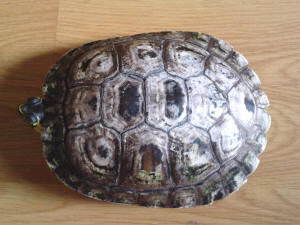
|
|
Painted Turtle Problems... shell 5/23/10
Hello,
<Hiya - Darrel here>
First off, sorry if this jumps around a little. I'm sure
there would have been a better way to organize this all.
<Not to work, Heather!! My mind is like a steel trap!>
<[Editor's note: Yes, his mind IS like a steel trap -
everything that goes in, comes out mangled]>
We have an adult female painted turtle named Rembrandt (thought
she was a he until he laid eggs!) my step-son found at a park
about a year ago. We had her for about 3-4 months and I noticed
some white spots on her. I had been doing a lot of research on
turtles because I wanted to make sure we did everything right. I
took her to the vet and he said she was a good weight and size
and that she did indeed have a small case of shell rot. At the
time it was just a little on the edges with a small spot about
the size of a pencil tip here and there. He got rid of the
slightly "mushy" very edge of her shell on the back
right of her top shell. Gave us Betadine solution to put on twice
a day and told us to keep her in a dry place for part of the
day.
<Sounds like a good start, but I'd have had her out of the
water ALL day except for feeding time.>
Each day for a couple of months I had religiously taken her out
of her tank, dried her off, put the Betadine on her, and had her
crawling around in the bathtub. It didn't really look like it
was getting any better or worse for that matter. I wasn't
sure what I was looking for it to do. We had about 20 gallons of
water in the tank, a 75w heat bulb and a uvb light with 40 gal
filtration. We changed our water changing habits making sure that
we did a 50% water replacement more often and changing the entire
tank water more frequently as well as change the filter more
often. We are also using a water conditioner and Nutrafin Water
Clean. When we first got her we could not get her to eat the
ReptoMin and gave her shrimp. We've later found out that
shrimp were packed with bacteria and could have actually aided in
the bacteria growth! Yikes! She finally got used to eating
ReptoMin and she eats this exclusively. We tried the meal worms
and she didn't take to those very well.
<ReptoMin is a fully balanced diet for her. It is essentially
identical to Koi pellets, which is what I feed my hard shelled
water turtles. They're nutritious and fully balanced AND fare
less expensive>
I'd noticed that that the bottom of her shell became more
cloudy colored. I started to worry that the shell rot was getting
worse!!! I decided to start putting her in the tub again as we
had some more Betadine left and this time moved the heat light
into the bathroom while she was in there (originally the vet said
it wasn't necessary and that she could be without the light
for the time she was in the tub drying out). I noticed that she
would dry out and there was white residue on her. There
doesn't seem to be any soft spots on her though. There are
still the little white spots on her shell here and there the size
of a pencil tip and somewhat scratch off with my nail.
<The treatment isn't very effective>
I then started to research the "whiteness" that later
developed on her shell thinking it wasn't shell rot but
rather something else. I found some info on problems with
minerals in the water. I realized that last year our water
softener died on us. We've not replaced it yet. We've
since increased our filtration to 80 gals (2 - 40 gal filters).
When the water evaporates there is a "ring around the
tank" and also if any water splashes on tank lid it dries
and there are white spots. So to me I wonder if that is what the
white on her shell is.
<You'd be surprised home many times I get an emergency
call about white spots that turn out to be just water spots &
mineral deposits, so yes, it's possible>
Her shell is not soft and when it dries out a paper thin layer
can be easily peeled away with needle tipped tweezers to reveal a
more "colorful" shell below but still the underbelly is
not very vibrant. However then it would get all cloudy again
within a number of days. I know they say "do not peel away
any of the shell" and I feel awful for doing it.
<Yes, it's generally a bad idea. Things that are supposed
to shed will shed naturally - the underlying material isn't
"ready" when the scutes first start to loosen.>
But when it came off it was very thin and somewhat brittle.
Somewhat difficult to explain so hopefully you understand.
<You're explaining it perfectly>
However, there was one small area that is right by her front
right leg that when that dried layer was removed it reveled a
very vibrant color of green and red. But then I noticed this
color was gone a day or two later!
<This is natural for turtles her age. The colors darken as
they age and when new shell is exposed it almost immediately
darkens to match the other areas>
Now it is a cloudy white color with a red color behind it. More
pink like. Almost like bone. I fear that that little layer was
not just a paper thin layer but rather one two many layers. There
is no bleeding. Does seem to bother her if I touch it.
<There are several possibilities here, Heather. The worse case
is that she's developed and infection that has become septic
(spread to her blood and therefore to all organs in the body).
The telltale evidence is that shell, skin and/or bones start to
take on a pink hue to them and the pink looks like it's
coming from "underneath" rather than on the surface.
This requires an immediate trip to the vet and a strong case of
injectible and oral antibiotics.>
<On the other hand, this could be a case of shell damage from
the (suspected) fungus. When the scute material (the plates that
make of the shell) is damaged and dies for some reason, the area
that dies sheds the last scute and what you see underneath is
indeed bone, which '¦ surprisingly '¦ looks
like bone. Beige with just a tiny bit of pink.>
<Turtles with a dead scute can go on to live happy and
productive lives -- they scute area simply needs to be cleaned
with peroxide and alcohol weekly to prevent algae from growing
into the bone.>
She is very active. She swims and eats just great.
<both good signs>
What is it that we are doing wrong? I'm sure we could clean
the water more often even and change the filters even more.
Could it be that she has mineral deposits? I have noticed that
the edges of her shell where she originally had the shell rot are
really hard and they are off white.
<It could be, but at this point it sounds like it would be a
serious case>
Almost like how you get lime build up around a faucet.
<yep>
The cloudiness on the underbelly is off white as well. I'm
wondering if she needs to go back to the vet or if this is common
with shell rot that it just takes a very long time to shed that
edge off and get a "fresh start". I would like to try
to correct any of our problems before taking her back into the
vet just to get whatever meds and then it only be a band aid for
a problem that ends up persisting. I will try to take pictures
and send them if you think it is necessary. Please let me know if
you need any additional information.
<If I were to take one guess, it would be mineral deposits.
BUT, as you said, there are more than a few slightly different
symptoms, so it's best not to guess.>
<Here's what I'd do: First, read the enclosed link on
treating illnesses. Especially the part about warm, dry
isolation. Even though we don't know what's wrong with
Rembrandt, everything that COULD be bothering her gets worse if
she stays warm & moist and gets better if she stays warm
& dry. As long as she gets a shallow bowl of water for 5 or
10 minutes a day in order to drink, poop and eat, she can spend
months out of water. She won't LIKE that (especially if
it's just mineral deposits after all) but it's safe for
her. The next thing I'd do is see that she gets some natural
UV (sunlight) every day. I'm talking about direct, natural
sunlight, as in taking her for a walk for 15 to 20 minutes a day.
Both of these things will promote her own natural healing>
<The key to water spots or mineral deposits is that
they're right on or near the surface and respond well to
cleaning. Mix some household vinegar and lemon juice (50/50 mix)
and place some on a cotton swab and then gently scrub a few spots
on her shell. Let her air dry naturally and repeat again in an
hour. After two treatments, a water spot will be gone or show
remarkable relief.>
<Lastly, no don't wait to fix whatever might be wrong with
the environment. Fix Rembrandt first. The symptoms you have
described are just varied enough that it's worth a trip to
the vet. If it is a bacterial infection it's not getting
better and will get worse untreated.>
<Two links: One on treatment (warm, dry isolation) and another
on general care. Match up your care against the guidelines and
see if anything can be improved>
Concerned New Turtle Owner,
Heather
<treatment:
http://www.wetwebmedia.com/FWSubWebIndex/treating%20RES%20Dis%20DarrelB.htm
>
<General Care: http://www.wetwebmedia.com/FWSubWebIndex/RESCareBarton.htm
>
Re: Painted Turtle Problems 5/24/10
Thanks for the info Darrel!
<Yer welcome!>
I've taken some pictures today.
<She's a pretty girl>
I've included different ones so as to illustrate the concerns
I have. Hopefully they are clear enough. The bright white (or at
least seemingly bright white) spots tend to really show up the
drier she is.
<From here, those white spots look like chips in the very
outer skin of the scutes. Very common and nothing to worry
about>
This is evident in the different bottom shell shots.
The area on her belly you will notice looks very cloudy and it
almost looks like its something under the top layer.
<Or the inside of the surface keratin is discolored>
However, like I'd mentioned before, after peeling away that
very outer brittle layer (shame on me) it still is cloudy
underneath. Is this from poor water and "stains"? Or is
this a terrible infection?
<Infections don't present that way normally. For some odd
reason, I'm thinking a calcium deficiency>
I also showed the site of the original shell rot and how it has
become a very hard yellowish color. Is this a sign that it has
never healed or is this a normal healing process? I also took
pictures showing her eyes and beak so that you can see how clear
they are. She is fast when I put her down to crawl around. She
tries to climb quite vigorously.
<My guess is that she's generally healthy!>
I feel terrible about the one scute on the right side. It seems
to become more white as she dries. And there is a definite ridge
between that area and the surrounding. So it seems the damaged
shell thought is probably true. I feel terribly terribly awful
because had I not tried to remove the cloudy peeling scute at
least she'd had something there even if it were a dead one.
If indeed the last scute has been shed is there anything that can
be done? Is it like this forever?
<Yes. It's not terribly debilitating for her and she can
live a happy life and even sell Amway if she wants. What you need
to do is periodically swab the area with hydrogen peroxide and
then coat in Betadine (once a week or so) to prevent an
opportunistic algal growth for getting a foothold.>
She has that area in the back that was the result of the original
shell rot damage where the vet broke off the very edge. It is of
course not a smooth edge anymore and there is a pit here and
there but some she had when we got her. Will any of her shell
"repair" with age or is it permanently
"deformed"? Will the spot by her right leg ever get
better? That is a very beginner question I'm sure. Can you
tell by these photos if she seems to have any terrible issues? I
don't want to hurt her and I don't know if it is better
to set her free or not.
<First - you're doing well & she's doing well.
Second -- and mainly for the rest of the readers -- DO NOT EVER
EVER EVER EVER *E*V*E*R* release an animal that has been in
captivity for much more than a few hours into the wild. EVER.
There is nothing but chances for bad things to happen - to her,
to the habitat, to the community she'll be joining. Not
ever.>
<Ahem. Heather, you're doing fine. Make sure she gets
proper nutrition and UV lighting. Check, double check and triple
check those things. Due to her shell condition, she'll
benefit from a bit more attention to water quality than
otherwise, but you don't have to be paranoid about it,
either.>
<Get some calcium supplement pills. Try to find some that are
pure ground oyster shell, but if that's not easily possible,
calcium & phosphorous is OK. Smash one up & mix it in
with a half spoonful of wet cat food and try to get her to eat
it. Supplement with a ground up calcium pill twice a week for 2
months (or wuss-out and go to the vet and pay a bunch of money
for injectible vitamins & calcium). I think, with just a bot
of extra attention, you can improve the shell quality without
making yourself a nervous wreck>
Thanks,
Heather
|
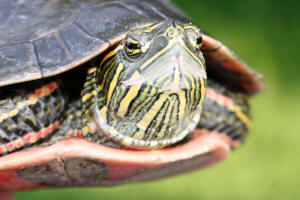 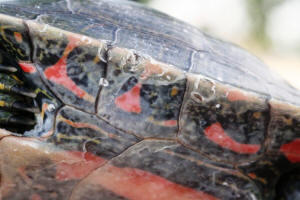
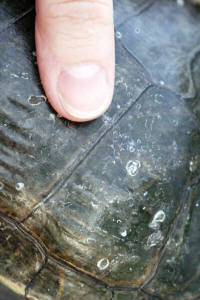 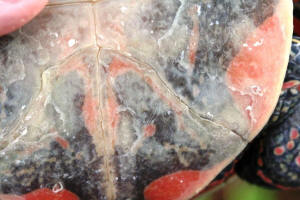 |
Broken shell, RES 5/14/10
Hello, I have a pair of baby RESs and today one of them an accident
<How? Turtles don't tend to fall down stairs. By definition,
turtles are well armoured and resistant to damage; to injure themselves
sufficiently to start bleeding, something pretty nasty must have
happened. Check children aren't playing with your turtles, and that
their enclosure is safe from dogs and cats. Obviously baby animals of
all sorts are curious and a bit slow at recognizing danger, so it's
vitally important you keep your pet turtles safe.>
and broke a small part of it's shell. It's eyes bled a
little
<This is a very serious symptom.>
but he is still walking but I'm not sure if he will eat
anything.
<May well be injured internally.>
Do you think he has a chance of surviving this?
<Yes, but he will need to visit a vet or animal rescue agency. An
x-ray will reveal whether there are internal injuries or broken bones.
Without being looked at, a turtle injured in this way may be in a great
deal of pain and very likely to sicken and die. So don't hang
about! Call the vet now! Cheers, Neale.>
|
Two Baby Sliders with black spots?
5/10/10
Hi !
<Hiya! - Darrel here>
I recently bought two baby red eared sliders about a week ago. I
assume they are hatchlings they are only about an inch
across.
<You are a good presumer>
I have ordered all the proper things they need online and have
about half of it, for example I have a 20 gallon tank with about
5 gallons of water in it, I have a big rock above the water for
basking, a temporary heat lamp (waiting for the correct basking
bulb to come in, I am using a 100 watt incandescent bulb) I even
have a fluorescent light for UVB rays. I also have a heater and
keep the water at approximately 80 degrees.
<I usually use a 75 to 100w incandescent bulb as my basking
lamp, too.
They're cheap, energy efficient and get the job done!>
I am feeding them Zoo Med Hatchling Formula and Baby ReptoMin
Pellets.
<I use small sized Koi pellets when they're hatchlings and
regular sized Koi pellets thereafter. Koi pellets are a
completely balanced diet! Then I toss in (literally) an earthworm
once a month or so - just as a treat.>
I am making the best out of what I have for my new baby turtles
while waiting patiently for everything else to come in. However
recently one of my turtle seems to have black spots between some
it's scutes and about two of these areas have started to turn
whitish. It has no odor, it's not unusually squishy, or
anything like that it feels normal it just looks kind of gross
and it seems to me that there is something wrong with it. However
I've done a lot of research on it, fearing that it is shell
rot, and none of the pictures look like my turtles problem, one
kind of did but not majorly, and other than that, my turtle has
none of the symptoms of shell rot, nor do any other causes make
sense.
<Is the shell nice and firm?>
My turtles are fine they swim around, they eat properly, bask,
all that, their behavior seems normal and fine. I am just getting
worried about him, is there something wrong with him, does he
have shell rot?
<Doesn't sound like it to me, Tylan. Take some household
vinegar on the end of a Q-tip and rub the area and lets see if it
just cleans off. If not, a VERY gentle scraping with the edge of
a razor blade -- VERY gently -- to see if it's a hardened
material or some sort.>
<read here:
http://www.wetwebmedia.com/FWSubWebIndex/treating%20RES%20Dis%20DarrelB.htm
>
Re: Two Baby Sliders with black spots?
5/13/10
Thanks Darrel, I tried the vinegar and it didn't seem to do
anything however the black spots are no longer so white in the
areas they were.
<That would indicate that whatever is growing in UNDER the
scutes '¦ so the vinegar seeps in, but a scrubbing is
not possible. Keep trying>
Also what is this on his stomach? (first attachment)
<The most likely is simply an abrasion -- he's rubbing
against something that has cut his plastron. Keep him warm and
dry for a couple days and put some Neosporin on it each
day>
The second attachment shows the black/darker spots on his scutes
and In between them and you can see the few white spots towards
his head on his shell.
<He may be heading for a fungal infection. Read this article
and treat accordingly
http://www.wetwebmedia.com/FWSubWebIndex/treating%20RES%20Dis%20DarrelB.htm
>
|
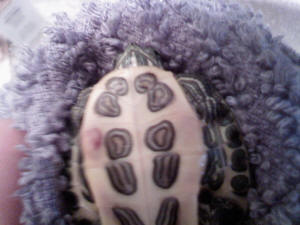 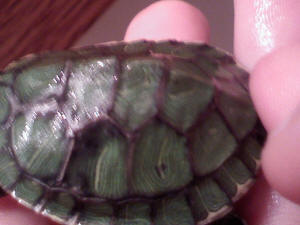 |
|
Re: Two Baby Sliders with black spots?
5/14/10
The redness on the bottom doesn't seem to be on the outside
it looks like it's underneath, it's not open.
<It could be a sign of an internal infection, but that's
normally only seen on extremely sick animals - that would have
many, MANY other symptoms as well. My suggestion is that you keep
him clean around there, alternate days swabbing the area with an
antifungal cream (like Lotrimin) once day and an antibiotic cream
(like Neosporin) the next. Let him stay dry for an hour after the
swabbing (put him in a tub or box with a towel on the bottom) and
let's see what happens in 3 weeks.>
<Darrel>
Re: Two Baby Sliders with black spots? -
5/23/10
Thank you for all your help Darrel, but unfortunately he passed
away last night.
<On behalf of Bob Fenner and the rest of the crew here,
we're sorry for your loss, Tylan>
Thanks again,
Tylan
<You're welcome, Tylan. Perhaps in some way, what is
learned from this sad experience can be used to help make life a
bit better and healthier for the other turtle and -what-I-hope
are many other pets in your future.>
<our thoughts are with you>
|
turtles, RES... care... shell... 4/27/10
My son bought a red ear slider turtle at a store about 3 weeks ago.
<Helen, my heart sinks when I read this. The problem with kids is
they have no idea at all about what animals need to do well. Actually,
some do, and I hope you're son is one of them. But my point is that
often they don't, and
even if they know what they need, they don't have the funds or the
time to provide those things. Think very carefully about whether you
want to keep this pet turtle. Start reading here:
http://www.wetwebmedia.com/fwsubwebindex/redearsliders.htm
http://www.wetwebmedia.com/fwsubwebindex/RESCareBarton.htm
>
The shell is about 3 inches.
<Going to get a lot bigger than this, around the size of a dinner
plate.>
It was in a tank with bigger ones. It is in a tank by itself and eats
good and gets all the right light it needs.
<Let's be sure you understand what it needs to eat and what sort
of light it needs. Folks often delude themselves on these. Turtles
can't really survive on just turtle pellets from the pet store. The
pellets are too high in protein and lack the required fibre. Let's
be clear that skipping dietary requirements will simply mean you get a
sick turtle and expensive vet bills. Fortunately, providing the green
foods they need is easy: a bunch of cheap Pondweed or equivalent will
last a week or two, and provide plenty of fibre and vitamins. As for
lighting, what turtles need isn't
visible light at all, but infrared for warming up and especially UV-B
for vitamin synthesis. You can get some excellent combination heat/UV-B
lamps that do the trick. Don't have UV-B? Well, unless the turtle
is outdoors
most of the year, it IS going to get sick. Again, skipping on a UV-B
lamp is just going to lead to a sick turtle and more vet bills. I
cannot stress this point too strongly: when turtles get sick,
there's little to nothing you can do with home remedies, and the
only humane treatment is to take your pet turtle to the vet. Some folks
have money to spend, some folks don't. If you want to save your
pennies, don't economise on the food, heating and UV-B that turtles
need. Can't afford those things? Then don't keep turtles.
Simple as that. These ARE NOT cheap pets.>
My question is what is making the tips of it's shell turn
transparent?
<As turtles grow, the outer plates of the shell will slough off the
shell, and as they peel away, they may appear transparent, rather like
patches of dead skin on humans after sunburn. For one or two such
plates -- called scutes -- to be wearing off at any one time is normal
and nothing to worry about. But if the turtle can't bask under a
warm lamp, and isn't receiving adequate UV-B light, and the water
isn't kept clean with a big filter and regular water changes, the
shell can "go bad" in lots of ways. Deformities are common,
as is something called Shell Rot where fungus develops between the
scutes. Because turtles grow slowly, it often takes months for problems
to show up, so you really do need to prevent problems rather than try
to cure them. I hope I'm not sounding too negative here, but
I'd guess something like 95% of the turtles sold as pets come to
grim, premature endings through some sort of neglect. Most of those are
turtles "cared for" by children, and I really cannot stress
too strongly how inappropriate
these animals are as children's pets. If you and your son are
prepared to share the tasks and you're able to keep an eye on
things, that's great, and you'll doubtless get on fine. But
bear in mind these turtles live for 20 years, get to the size of dinner
plates, and eventually require vivaria about the size of a bathtub.
Female turtles are further complicated by their need to lay eggs
otherwise they tend to become egg-bound (and this can happen whether
there's a male with them or not). So please take some time to read
those two articles and the linked healthcare articles. Hope this helps.
Cheers, Neale.>
Neale's reply to 4/27 turtle FAQ 4/28/10
Dear Neale,
<Sue,>
I happened to be on the site doing some work on the turtle FAQs and
just happened to see your response to Helen today whose son just bought
a red eared slider (FAQ entitled, "turtles,
RES.care.shell.4/27/10).
<Oh?>
I just want to say that I felt it was an EXCELLENT response and want to
compliment you on it! You not only answered her question, but gave her
the "complete picture" in terms of needs/requirements
concerning diet, UVB,
heat and water quality, as I've seen Darrel do as well. You really
hit the nail right on the head with each of the key points you raised,
as well as provided the appropriate care links for further reading.
<Ah, this is good to hear. Balancing honesty with courtesy is always
tricky, for me at least, and sometimes I miss the mark and folks feel
that I've treated them like dummies.>
Really, your response should be kept handy and later given as THE
"canned response" to any future FAQs you receive where people
say they are feeding their turtle all the *right* food, giving their
turtle the *right* amount of light and heat that it needs, having the
*right* water quality and temperature, keeping their turtle in the
*right* size aquarium - but without mentioning any of the details about
what they really ARE providing their turtles when they write in!
<This was precisely my aim. Without data to the contrary, I
can't assume they're providing the right conditions for their
pets. When it comes to pets sold in shopping malls and the like, or
purchased by children, my whiskers twitch with the likelihood that the
new pet isn't being given adequate care. That may not be the case
in that instance, but I always try to throw out some pre-emptive
information just in case.>
With all the misinformation out there on the web and unfortunately even
from pet store employees themselves, it really cannot be assumed that
people really DO know the *right* thing to do when it comes for caring
for their turtles.
<Quite so.>
So excellent job, Neale on your very thoughtful and thorough response,
and in general, for all the valuable education (and time!) that you and
the other crew members provide for the community!
Sue
<Thanks for saying so Sue. It's nice to get feedback like this,
and does indeed make me feel all nice and glowy. Cheers, Neale.>
Re: Neale's reply to 4/27 turtle FAQ 4/28/10
Much deserved Neale ... and at least from my read anyway, I definitely
don't feel you were discourteous at all!
<Didn't hear back from that querier, so it's entirely
possible she felt I was a bit harsh. I do get the odd piece of hate
mail.>
Hopefully she will appreciate that she was one of the fortunate few who
was actually told all these things (including the long term care
considerations which are equally important) BEFORE problems occurred!
And if not, at least the turtle will! :) I've got to believe (or at
least hope) that most people who buy a new pet really do have the
animal's best interests at heart,
<Initially at least, I think most do.>
and truly do want to learn (or at least be reassured) about their care
requirements.
<Again, I think most do. But the costs of pet ownership often become
serious issues, whether we're talking about vet bills, proper diet,
exercise in the case of dogs, and various other things. As a species we
have a remarkable capacity for self-delusion, telling ourselves that
dogs don't mind having their tails docked, or cats don't mind
having their claws surgically removed. If I might be slightly political
for a moment, one could even argue the "Birthers" are a
classic example of people who've deluded themselves into believing
some remarkable nonsense simply because
it reinforces their own preconceptions. You get the same thing here all
the time: The pet store told me I don't need a heater for my Betta
or my Turtle, and they're professionals, you aren't, so I'm
going to believe them and keep my Betta or Turtle in a small, unheated
jam jar.>
Your response will hopefully also benefit others who read it as
well.
Though it will never happen, personally, I think all the things you
mentioned should be posted up on turtle tanks in pet stores everywhere
- to educate not only parents, but also other adults BEFORE they decide
to buy them - and in many cases, even the pet store employees
themselves!
<I agree with you 100% here. Thankfully, pet turtles are now pretty
uncommon in the UK, but as a kid they used to be among the cheapest
pets you could buy. Or rather, the turtles (we call them terrapins
actually) were very cheap; the equipment they needed wasn't. So the
vast majority ended up dead. Weirdly though, some were dumped in
rivers, and in a few places, notably Wimbledon Common in London,
Red-ear Sliders have become
established. I probably don't need to tell you that the only thing
worse than a dead pet animal is a live pet animal in an ecosystem where
it doesn't belong. But that's an argument for another day!
Thanks again for writing, Neale.>
Re: Neale's reply to 4/27 turtle FAQ
4/30/10
Neale: (Just a reply to your email; no need to post this to WWM - has
nothing to do with turtles!)
<Indeed!>
No, you're right - you don't need to tell me about animals
landing up in an ecosystem where they don't belong ... my (RES)
turtle actually IS one of those animals!! He literally showed up at the
back door of my house last summer! Not sure how he got there, but he
was trapped on all sides by stairs and stone walls that are at minimum,
a foot high. He was only a baby and had no way to climb over them, so
most likely would have died had he not been found. Glad to say he's
doing great now and very spoiled!
<Very good.>
I can also definitely relate to what you said below about
"unplanned costs" when it comes to owning a pet. My 17 year
old kitty came down with cancer (fibrosarcoma) last fall, which turned
out to be only the beginning of a 4
month non-ending stream of expenses that wound up costing in the
thousands.
It started with the local vets not being able to perform that kind of
surgery and referring him to Tufts (Boston). $4,000 later... he
survived the surgery and slowly recovered. However, it was a major
surgery that weakened him and landed up exacerbating some of his other
underlying medical conditions (kidney, heart, etc).
<As is often the case with older cats. Have been there, done that
with both a 17-year-old Siamese and a Burmese of similar age.>
In December, he came down with a respiratory illness. I brought him to
his (local) vet who was out, and had another vet covering.
Unfortunately, this vet wasn't aware of "Chili's"
underlying heart condition, ran his IV too
fast, and sent him into heart failure! Of course, he could do nothing
more for him at that point, and so again referred him back up to Tufts!
After a frantic 1 hour and 15 minute seemingly endless ride up there,
they again saved him...another $2,000...but from that point on, I had
to take him up there once, sometimes twice a week for ultrasound guided
thoracocentesis (which local vets also didn't have the resources
for!) to drain fluid from his chest (which slowly accumulated back up
over time) in order to keep him alive...at a cost of $250 for each (10
minute) procedure.
<Yikes!>
Besides all of the bills was the agony I went through for the next 3
months about whether or not to put him down! Unfortunately it was not
so "black and white". He tolerated the thoracocentesis very
well (a 10 minute, quick
procedure), was still active, eating well, seeking affection...etc.)
Tufts said they'd never seen anything like it; even dubbed him
their "miracle" cat. However, in order to keep him this way
and not suffering (which was the only way I could justify not putting
him down) meant maintaining a constant vigil over him, and bringing him
right up to Tufts at the first, even slightest hint of labored
breathing. My nursing skills finally landed up coming in handy ...
however, was VERY stressful!
<For all concerned I'm sure. But it's good you were able to
help out here.>
Unfortunately, though, in the end, the cardio drugs he was on finally
pushed his kidneys over the "tipping point" and he died in
March. The only blessing was that when this happened, it happened fast
- he was actually
active, affectionate, and ate well right up to the night before he
died; only went downhill that next morning of his death.
<Often seems to be the case with cats; they have a certain sort of
will power, but then they turn a corner, and just seem too tired for
life.>
I was also relieved that I never had to be put in the position of
"playing God", and also very grateful that I got those extra
3 months of special time with him (he unfortunately had taken a back
seat over the last few years when kids arrived on the scene!)...
however, that privilege unfortunately came with a VERY high price
tag!!
<Sue, thanks for writing and sharing all of this. It's never
easy to watch a loved pet get sick, and one thing with fish is that
we're often a bit detached from that, since mostly they're
either perfectly healthy or else close to death, with not much time
between the two extremes. With cats, dogs and other "furry"
friends that's often so very different, and potentially painful for
both pet and pet owner. But your experience here is a reminder that
when we buy a pet, we're sometimes getting bad times as well as
good, and expense as well as pleasure. Anyway, all best wishes to you
and whatever beasties inhabit your home at the moment! Cheers,
Neale.>
My female red eared slider -- 04/22/10
Hi, my name is Kim
<Hiya Kim, Darrel here>
I have a female red eared slider. She was a gift. I believe she is
about 10 or 11 months old. I have her in a 30 or 40 gallon tank she has
rocks, gravel and a light at the top of the tank.
<Make sure the gravel isn't a size she can swallow>
I can't afford a filter for her yet but I do clean her water every
5 or 6 days.
<That's fine, if the tank or container is small enough, then
water changing is actually more efficient than filtering - and even
WITH a filter you'd need to change the water every 6 weeks or
so><<RMF would say/state every 2 weeks>>
I feed her Zoo Med Aquatic Turtle Food 2 or 3 times a day about 8
pellets every feeding.
<That might be a little much, Kim, 8 pellets once a day is more than
enough>
Today I noticed green fuzzy stuff on the top of her shell so naturally
I Googled and came to your web site also the back edge of her shell is
very soft. So my question is how do I keep her warm, what can I do to
make it better for her? Currently I took her out of her tank and have
her in a big plastic bowl with aquatic sand.
<Her tank is OK until the problem is actually solved>
I put her under some warm water then dried it off with a Q-Tip and
green came off of her and I do have vinegar but I do not have anti
fungal cream but I do have an anti fungal spray.
<It sounds more like algae than fungus, Kim.>
Please help me I do not have the means right now for a filter or a vet
visit keep in mind she was an unexpected gift.
<This is why pets don't make good gifts unless we're sure
the person wants one.>
<In any case, solving her problems is not going to require a vet
visit or be very expensive. My guess is that she's not getting
enough UV lighting so she can't produce Vitamin D and metabolize
the calcium in her food. 20 -30 minutes a day of sunlight that
isn't filtered through glass will probably firm up her shell in a
month or so.>
<Here is a link to the proper care of Red Eared Sliders -- and
you'll notice that nothing HAS to be expensive. The first order of
business is clean water (no heater), a warm basking area, UV-B lighting
and a proper diet>
<Read here: http://www.wetwebmedia.com/FWSubWebIndex/RESCareBarton.htm
>
|
Help Red Ear Slider Shell Not Smooth & Turtles
Growing Too Fast? -- 04/22/10
Hello,
<Hiya - Darrel here>
I found your article below. I bought 2 red eared sliders and this
sounds very similar to the issue/question I have. The scutes were
normal looking then as of last few weeks they seem to be growing
& looking more like tree rings from the growth. The pattern
on the scutes can't be determined anymore. It doesn't
look like a fungus but I'm new to this & the info on line
seems to be all over the place yet nothing on this. I've seen
pictures of juvenile red ear sliders & the patterns on their
scutes seem to be like when they were hatchlings (not my
guys/gals). I got them about 2 months ago now & they were the
size of a silver dollar. Now they are about 3 ½
inches. They seem to be growing fast?!
<Yes they do. Make sure you don't over feed them>
Also just prior to the shell changing they were shedding a lot.
The one that changed first was shedding the most. The shell
doesn't feel soft but I did notice today on the one that
started changing later a little dark spot in between the scutes
(where it looks like tree rings from growth). Also their shells
are not smooth like other pictures I've seen.
<When the scutes shed, they come off as very thin, almost
transparent sheets. Is that what you mean by shedding? If you do,
that's normal and healthy>
I'm also not 100% they are red ear sliders. One has more of
pink ears & the other doesn't seem to have any ears. They
definitely look like sliders though.
<Pink ears are often seen, sometimes just variations in shade,
sometimes after interbreeding with Yellow Belly turtles, another
of the many members of the Pseudemys genus that we just generally
call "sliders.">
I've attached the baby pictures and can send you pictures of
how their shells look now, but it probably will be tomorrow or
Wed. They are eating fine (actually little piggies - they ate 5
of 6 feeder fish I bought, however I was told the feeder fish
were too big for them but apparently not because one of them or
both of them at all 5 while I was at work. The last one still is
going strong & was the smallest of the 6 fish! They
don't' see to bother it.)
<First, turtles don't eat fish as a diet mainstay. Second,
feeder fish are notorious for carrying parasites. Third - since
they often don't eat the feeders, the feeders tend to grow
and thrive and before you know it they become pets that you have
to house, feed and care fore, etc.>
<No feeder fish!>
<Koi Pellets with an occasional earthworm as a treat>
<NO CAPES! -- Edna Mode>
<NO FEEDER FISH! -- Darrel>
I have a red heat lamp on at night, put the white 'grow/full
spectrum light 60wat' on during the day to be on the basking
rock (red sandstone) that sits on top of glass tea bottles (i.e.
green tea that I had & the bottles were perfect height so
they are the 'stand' for the basking rock). There is a
heater (a generic 10 gallon heater for now), in a 10 gallon tank.
The water temperature usually is around high 70s. They are
active, swim around, beg for food (prefer hand fed first then
will eat food that I dump in the water). Food right now is turtle
pellets, red/frozen "worms", dried shrimp & krill
(they love the krill the best & prefer to be hand fed that
one that best).
<You're actually taking too good care of them!!!>
<They don't need a heat lamp at night unless you live
north of the Arctic circle. A basking lamp for visible light
& heat as well as a UV lamp during the day '¦ but
at night let the basking area cool off normally and achieve room
temperature. That's their normal & natural land
cycle>
<No water heaters, either. Any room temperature comfortable
for you is comfortable for them. What we want is for them to be
offered the CHOICE of water around 68-72 degrees and a basking
area of 88-92 degrees and let them regulate as they
desire>
I change the water nearly weekly (keeping about ¼
to 1/3 or the original water & putting in Britta filtered
water that I let sit out to settle out). Also I've had to use
some tap water to top off on occasion but have water
conditioner.
<Again -- good work on your part, but not necessary. Unless
you live in an area with *exceptionally bad* or hard drinking
water '¦ tap water is just fine. I like that you take
good care of them, don't get me wrong '¦ I just
don't want you to worry so much. So as long as it makes you
feel like a good turtle mom, please go ahead>
Also, nearly daily I have to put in water that has evaporated (we
are in a semiarid environment and with the heat lamps daily I
have to top it off to bring the water level up to the rock so
they can get on & off of it). There is a whisper reptile
water filter in there too (I do need to replace the filter as the
last tank cleaning yesterday is was gunky but I'm out in
nowhere so it'll be this week-end before I can get another
one so I cleaned it out with hot water).
<Nice>
I'm trying to figure out if they are just growing really fast
(i.e. tree rings looking stretch marks around the scutes, the
original size scutes are still there but the pattern is not as
evident.) Also the shell isn't flat, sort of more like a box
turtle bumps. Eyes are fine, activity is fine (they are good
swimmers), basking is fine, I just don't see anything wrong
except that from what I've read that the shell is suppose to
be smooth on top, plus pictures all show the patterns for guys
that are 3 ½ inches but these guys are loosing it
(or maybe the scute is shedding & that's why I
don't' see it?). I feed them twice a day but not a whole
lot. They are 'beach bums' where basking is concerned so
that seems fine too.
IF you can provide any help it would be greatly appreciated. I
think they are growing too fast? Should I be concerned?
<They probably are a bit '¦ simply because you keep
their metabolisms higher than they would see in the wild. If the
water is in the high 70's they're process much faster
than they ever would in the wild. Remove the heater and let the
water temp become room temp. It will slow them down a bit, but
they'll thrive a bit better>
I've attached a few of the baby pictures. These were taken in
mid-March after I had them 2 weeks. The one on the left (aka
"Stretch") is the one that started shedding first. The
pattern on his shell is also not as symmetrical as the other (aka
"Loh"). Stretch is more of a swimmer then Loh but both
go to town. Stretch is the bigger piggy & basker too. He also
went thru a LOT of shedding 2 weeks ago. As you can even see in
this picture Stretches scutes are not all smooth. Neither had a
lot of yellow but now only the edges are yellow. I've tested
the edges & they do not feel soft.
<I've examined all the pics and everything looks
good!>
<You're doing well, but here's a link to a fantastic
article that covers the basics in a bit more detail.>
<http://www.wetwebmedia.com/FWSubWebIndex/RESCareBarton.htm>
AmberRae
|
 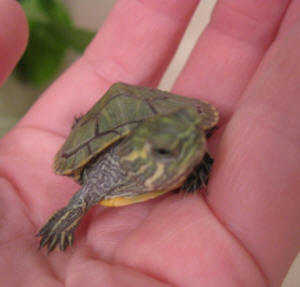 |
|
Terrapin shell problems -- 04/22/10
Dear Crew
<Hiya - Darrel here>
I have recently been given this terrapin, which had been kept in
very poor condition! I have provided him with good lighting, diet
and space etc but I would like to know what is wrong with his
shell?
<From the picture Rebecca, it appears as if she's just had
a hard life. IT appears that you have a Cooter (Pseudemys
cocinna) or a Yellow Belly (p scripta). The green discoloration
is from algae that will lessen in time as she has access to clean
water and proper basking conditions '¦ but even in the
wild many adult Sliders and Cooters have algae on their shells.
The scuff marks on the shell can be just signs of wear and tear
and nothing to be alarmed about>
<Is the shell nice and hard? If you look really closely at the
shell, the whitish areas -- is the material soft and smelly like
a fungus? Does it scrape off? Or does it simply appears as the
scutes themselves are discolored? The more explanation you can
provide, the better I can advise you>
also if I could treat the problem myself before I take him too a
vet?
<If her shell is hard and he's active and eating, I
don't see a reason to be alarmed just yet. Keep her clean,
make sure he can get really warm and dry and try cleaning her
shell with a cotton swab every few days and let's just see
how she does>
<Care sheet: http://www.wetwebmedia.com/FWSubWebIndex/RESCareBarton.htm>
<Treatment:
http://www.wetwebmedia.com/FWSubWebIndex/treating%20RES%20Dis%20DarrelB.htm>
|
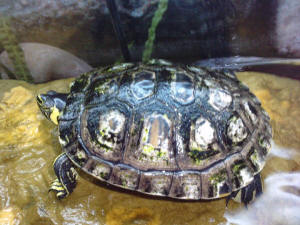
|
Re: terrapin shell problems
4/28/10
Hi Crew
<Hiya - Darrel here>
This is a picture I took today of my terrapin. After
removing all the black stuff off his shell there is more
white patches underneath...they are hard like the rest of
his shell and don't smell at all...he is eating and
behaving normally but I am still very worried because it
looks so bad. Any information you can give me I would be
extremely grateful.
<Looks normal to me, Rebecca. In fact I have a number of
ones that look just like that in my pond. She's just
lead a harder life than some. Keep up the good work and
don't worry>
Rebecca
|
 |
|
RES, blk. shell spots? -4/6/10
Dear Crew,
<Hiya - Darrel here>
I have had my red slider turtle for four years and he has always seemed
healthy. Today I noticed black spots on his shell. I can't find
anything on the web that addresses this problem so can you help. I
change his water every week but this time it did seem more dirty than
usual. Any ideas?
<I'd like to see a picture, because no '¦ black spots
aren't unusual. As they grow older, the BRIGHT green turns to a
dull green which turns to an almost dark green/black.>
<Can you take pictures & send them?>
Thanks
|
|

